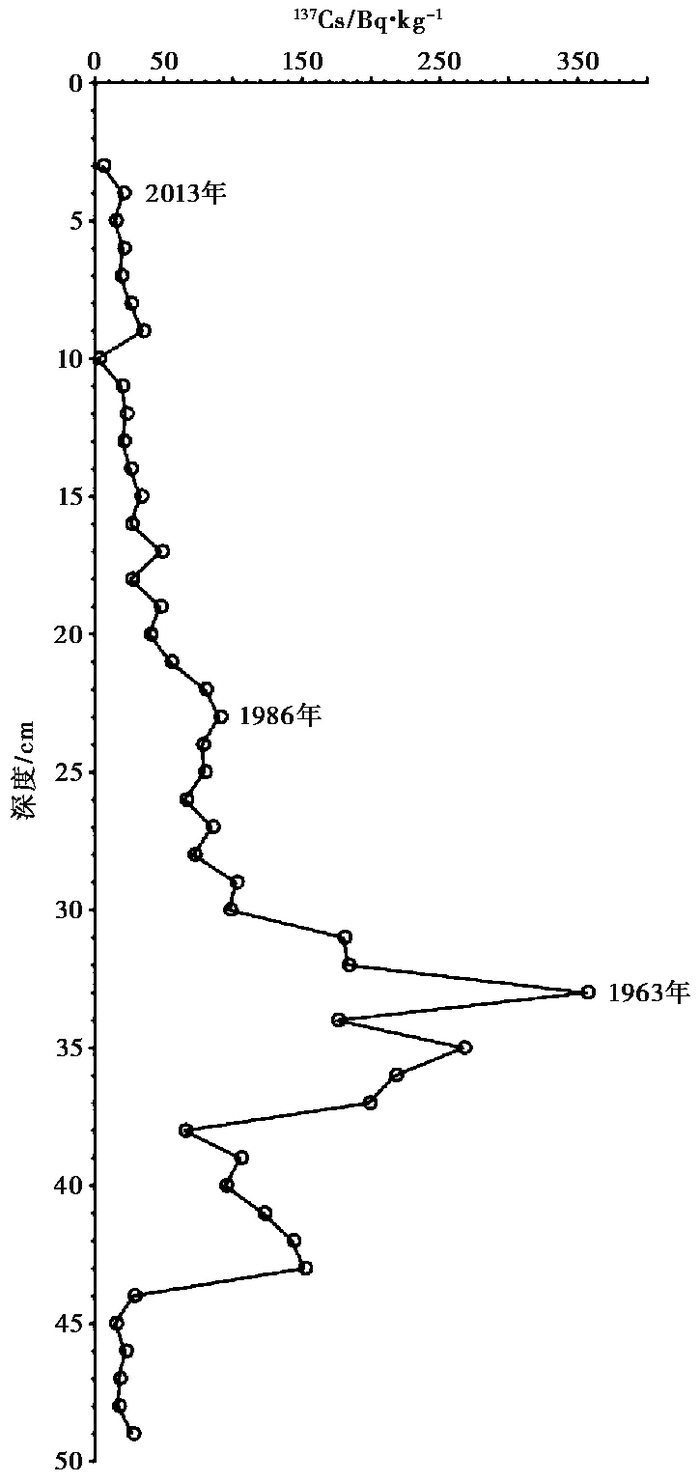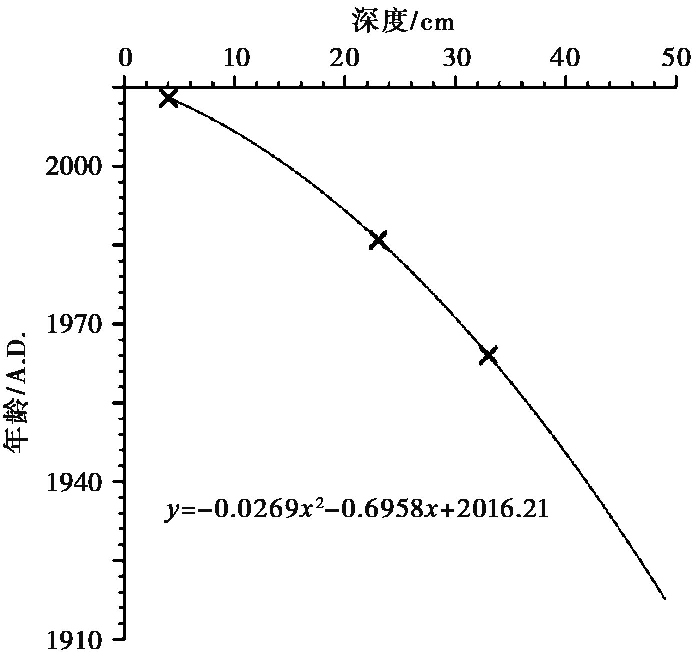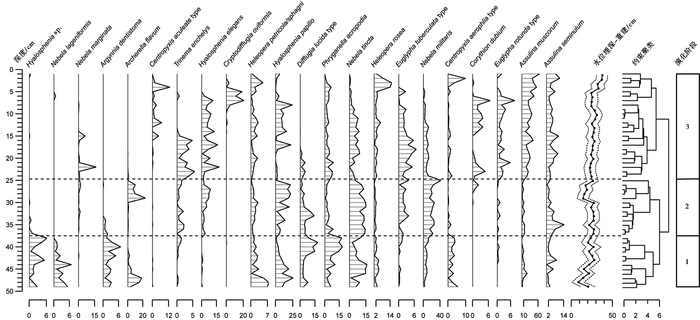② 东北师范大学地理科学学院, 长春 130024;
③ 东北师范大学国家环境保护湿地生态与植被修复重点实验室, 长春 130024)
有壳变形虫(Testate amoebae),又称有壳肉足虫或有壳根足虫,是一组陆生淡水生境下具有耐分解壳体的单细胞原生动物,主要生活在湖泊、淡水和泥炭地中。由于其对环境变化反应敏感,近年来在古环境研究中受到越来越多的关注[1~5]。在泥炭藓泥炭地中,有壳变形虫的种类和数量更加丰富[2, 6],其物种组成主要受地下水位埋深(depth to water table,简称DWT)影响。在欧洲和北美的许多研究中利用有壳变形虫-水位转换函数[7~14],定量恢复了不同时间尺度的泥炭地古水位变化[15~17],探讨了水位变化的气候意义[18, 19]和对碳积累的影响[20~25]。
东北地区是我国主要的泥炭分布区,特别是大兴安岭地区分布有大量泥炭藓泥炭地,但缺乏利用有壳变形虫进行古水位定量重建的研究。本文根据已建立的大兴安岭地区泥炭地有壳变形虫-环境因子转换函数模型(另文发表),尝试定量重建大兴安岭洛古河泥炭地古水位变化,并对重建结果进行显著性检验,探讨该泥炭地记录的近100年来区域环境变化。
2 材料与方法 2.1 研究区域概况洛古河泥炭样地(53°8′01.08″N,122°3′30.72″E)位于大兴安岭北部,海拔578m。该区属于温带大陆性季风气候区边缘,冬季寒冷干燥,夏季湿润温凉。年平均气温-4.3℃,平均气温在0℃以下的月份长达8个月;年平均降水量约428mm,季节分配不均,多集中在7~9月。洛古河泥炭地为典型的泥炭藓泥炭地。灌木层主要有笃斯越桔(Vaccinium uliginosum)、狭叶杜香(Ledum palustre L. var. Angustrum)和甸杜(Ehamaedaphye calyclata),草本层以苔草(Carex rigescens)为主。地被藓层主要有锈色泥炭藓(Sphagnum fuscum)、中位泥炭藓(Sphagnum magellanicum)和金发藓(Polytrichum commune)。
2.2 样品采集采样工作于2013年8月进行。采样时先将取样点表面整理干净,做20cm×20cm的标记,用刀沿边缘下切49cm至永冻层为止,小心取出样品,标记好层位方向,修剪成15×15cm2,按1cm间距分样,共获得样品49个,将样品放置到标有编号的自封袋内,送回实验室,冷藏保存。

|
图 1 研究地位置图 Fig. 1 Location of study site |
有壳变形虫样品前处理按照文献[6]推荐的方法进行:1)取2cm3泥炭样品放置于100ml的烧杯中,蒸馏水浸泡12小时以上,然后反复冲洗,使有壳变形虫壳体与附着基质充分脱离;2)蒸馏水冲洗样品并过300μm孔径筛,去除粗粒杂质,再将筛下样品过10μm孔径筛,筛除细粒的杂质,留下10~300μm的部分;3)蒸馏水冲洗细筛上的样品入15ml的离心管,在离心机上以3000 rpm离心5分钟,倒出上部清液;4)每个离心完毕的样品中分别加入一粒石松孢子作为外源计数标记,并滴入适量甘油密封保存,以备制作薄片观察、鉴定。
将制作好的薄片放在生物显微镜下放大200倍观察、鉴定并计数,个别需放大400倍。有壳变形虫种类鉴定依据文献[26~29],每个样品累计观察不少于150个壳体,若个别样品壳体浓度较低,则至少观察6个薄片。
2.4 年代测定方法剖面年代框架主要通过137Cs法获得。剖面共49个样品,于烘箱70℃烘干至恒重,每个样品取6~8g,磨碎,过60目孔径筛,装入直径75mm、高70mm的专用圆柱形塑料样品盒,然后放入ORTEC N型高纯锗伽马谱仪进行测试,测量时间80000s。为计算样品活度,我们使用ANGEL 3.0无源效率刻度软件,根据测试样品质量、密度以及在样品盒内的厚度等参数获得每个样品的效率刻度曲线,然后依据能谱中661.6 KeV峰面积获得样品的137Cs活度。剖面底部第49cm样品还进行了AMS 14 C测年。
2.5 数据处理根据有壳变形虫鉴定统计结果,计算洛古河泥炭剖面各有壳变形虫物种的相对丰度。利用已建立的大兴安岭地区泥炭地有壳变形虫与水位埋深转换函数模型(另文发表),对泥炭剖面古水位进行定量重建,采用广泛应用[7~17]的转换函数模型包括:加权平均(Weighted Averaging,简称WA)、加权平均偏最小二乘(Weighted Averaging Partial Least Squares,简称WAPLS)、最大似然(Maximum Likelihood,简称ML),并对重建结果进行显著性检验。利用Coniss约束聚类划分剖面水位变化阶段。水位重建和约束聚类借助R语言[30]的rioja软件包[31],显著性检验通过palaeoSig软件包[32]实现。
3 结果 3.1 年代洛古河泥炭剖面底部第49cm样品的AMS 14 C测年结果为102.6±0.3 pMC。剖面137Cs比活度变化见图 2,剖面底部49cm 137Cs比活度为27.06Bq/kg,并在33cm处出现了最大峰值356.18Bq/kg,对应全球137Cs沉降高峰1963年;23cm处137Cs峰值比活度为90.15Bq/kg,对应1986年前苏联切尔诺贝利核泄露事故。取样时,表层4cm为当年的活藓层。根据以上时标,我们建立了泥炭剖面的年龄-深度模型(图 3),剖面底部年龄为1918年。洛古河泥炭剖面记录了该泥炭地近100年的环境变化历史。

|
图 2 洛古河泥炭剖面137Cs比活度分布 Fig. 2 Specific activity distribution of 137Cs in Luoguhe peat profile |

|
图 3 洛古河泥炭剖面深度-年龄模型 Fig. 3 Depth-age model of Luoguhe peat profile |
洛古河泥炭样芯的有壳变形虫剖面图谱见图 4。49个样品中共计观察有壳变形虫41种,壳体总数19132个。主要种类包括苔藓鳞盖虫(Assulina muscorum)、半空鳞盖虫(Assulina seminulum)、凤蝶茄壳虫(Hyalosphenia papilio)、巧茄壳虫(Hyalosphenia elegans)、附石/泥炭藓截口虫(Heleopera petricola/sphangi)、顶足法冒虫(Phryganella acropodia)、染色梨壳虫(Nebela tincta)、军梨壳虫(Nebela militaris)等。从剖面变化来看,洛古河泥炭样芯下部以喜湿种类为主,茄壳虫未定种(Hyalosphenia sp.)、瓶形梨壳虫(Nebela Lageniformis)、Archella flavum等相对丰度较高,这些种类自38cm开始减少甚至消失。相应地,一些喜干种类,如暧昧蛹壳虫(Corythion dubium)、长圆鳞壳虫(Euglypha rotunda type)、苔藓鳞盖虫(A. muscorum)的相对丰度逐渐升高。

|
图 4 洛古河剖面有壳变形虫图谱 仅列出最大丰度大于5%的物种, 水位埋深由WAPLS模型获得, SEP(standard error of prediction)用点划线表示出, 根据约束聚类结果, 剖面水位变化划分3个阶段, 用虚线表示; 有壳变形虫从左侧到右侧是从喜湿到喜干的物种排列分布 Fig. 4 Testate amoebae diagram for Luoguhe peat profile. Only the taxa with the most abundance over 5% are listed. Depth to water table is inferred from WAPLS model with SEP (standard error of prediction) expressed in dotted lines. Water table changes of peat profile are divided into three phases, expressed in dotted lines according to the result of constrained clustering. Testate amoebae taxa are listed from left to right according to their hydrological preference from wet to dry |
根据剖面有壳变形虫物种组合,我们定量重建了洛古河泥炭地的古水位(图 4),并对重建结果进行了显著性检验(图 5)。结果表明,WA模型的重建结果未达到p<0.05的显著性水平,WAPLS、ML模型的重建通过了显著性检验。与剖面有壳变形虫种类变化相对应,WAPLS模型重建的洛古河泥炭地古水位也呈现逐渐下降的趋势(图 4)。38cm以下,水位埋深值较小,约20cm,泥炭地水位较高。此后水位逐渐下降,29~26cm经历短暂升高后,持续下降,到表层降至最低,水位埋深值达35cm。

|
图 5 洛古河泥炭剖面古水位定量重建显著性检验 DWT线表示重建水位所能解释剖面物种变异的百分比,点线表示p=0.05显著性水平的临界点,虚线表示剖面物种组成PCA分析第一轴的解释量,即DWT解释量所能达到的最大值。当DWT线位于点线右侧,表示重建结果显著;DWT线位于点线左侧,表示重建结果不显著 Fig. 5 Significance test on the quantitative reconstruction the water table. The solid lines mark the percentage of variance in testate amoebae assemblage of the Luoguhe peat profile explained by reconstructed water table. The dotted lines mark the critical point of the significance level of p=0.05. Dash lines mark the percentage of variance explained by the first axis of a PCA of the fossil data, i.e. the maximum value of percentage explained by DWT can reach. When the DWT line is located on the right side of the dotted lines, the reconstruction is statistical significant. While on the left side, not statistical significant |
基于137Cs年代框架,根据洛古河泥炭剖面有壳变形虫的种类、数量和组合特征,按照约束聚类结果、结合重建的古水位,可将洛古河泥炭地近100年来以环境变化大致划分3个阶段:
第1阶段:1918~1951年(49~38cm),这一阶段水位变化频率和幅度较大,水位埋深自12cm波动升高至23cm,喜湿的有壳变形虫如茄壳虫未定种(H. sp.)、瓶形梨壳虫(N. lageniforms)、齿口阿吉尼亚虫(A. dentistoma)以及A. flavum物种丰度较高。缺失指示干燥环境的暧昧蛹壳虫(C. dubium)、长圆鳞壳虫(E. rotunda type)等种类。说明该阶段洛古河泥炭地非常湿润。
第2阶段:1951~1982年(38~25cm),该阶段下部1951~1973年水位相对稳定,保持在距地表约22cm,此后经历了大幅度地快速波动,1973(29cm)水位骤升至距地表 15cm并保持至1980年(26cm)后又快速下降至24cm。从有壳变形虫物种组合来看,以指示较湿润生境的凤蝶茄壳虫(H. papilio)、巧茄壳虫(H. elegans)、染色梨壳虫(N. tincta)为主,指示较干生境的军梨壳虫(N. militaris)的丰度大幅增加,而茄壳虫未定种(H. sp.)、瓶形梨壳虫(N. lageniforms)、齿口阿吉尼亚虫(A. dentistoma)等种类显著减少甚至消失,至1973~1980年A. flavum才又明显增多。该阶段洛古河泥炭地仍比较湿润,但与第1阶段相比,已有变干趋势。
第3阶段:1982~2013年(25~0cm),该阶段水位持续缓慢降低,波动频率和幅度很小,水位埋深自24cm增大至34cm。有壳变形虫以苔藓鳞盖虫(A.muscorum)、半空鳞盖虫(A. seminulum)占优势,指示干燥环境长圆鳞壳虫(E.rotunda)、暧昧蛹壳虫(C.dubium)丰度增大,指示湿润环境的茄壳虫未定种(H.sp.)、瓶形梨壳虫(N.lageniforms)、齿口阿吉尼亚虫(A. dentistoma)和A. flavum基本消失。表明这阶段洛古河泥炭地在持续变干。
4 讨论 4.1 定量重建的显著性检验定量重建是古环境研究的趋势。利用生物指标进行古环境定量重建的基本思路是通过大量调查取样,采用不同数量统计分析方法,建立现代生物物种组成与环境因子的定量关系,即转换函数[33~35],然后将转换函数应用于剖面。既然是基于统计分析的定量重建,就不可避免涉及到重建结果的显著性检验问题。这个问题多年来未受到足够的重视。Telford和Birk[36]提出一种新的针对利用生物指标古环境定量重建的显著性检验方法。该方法认为重建的环境因子对剖面物种组成变异的解释量若超过大部分(95 %)随机变量的解释量,则重建结果就是显著的。依此标准,本研究中WA模型重建结果是不显著的,而WAPLS和ML模型则显著。因此我们的结果分析主要根据WAPLS模型的重建结果。
在采用多个模型进行古环境定量重建时,该显著性检验方法的确为重建结果选择提供了一个重要的参考依据。但对于未通过显著性检验的重建是否毫无意义,目前还存在较大的争议,对此Telford和Birk[36]也未给予完全否定,只是提醒我们这种情况下,对重建结果的解释需十分谨慎。Payne等[37]利用该方法对30个利用有壳变形虫-水位转换函数重建的古水位曲线进行了显著性检验,结果有25个未达到p<0.05。对此Payne等[37]指出基于生物指标-环境因子转换函数的古环境定量重建有坚实的生态学基础。只要基于高质量的现代训练样本集,即使未通过显著性检验,重建结果依然有意义。不同地点、同一地点的不同载体、同一取样地的不同岩芯、不同代用指标的记录重现性,以及对生物指标生态学认识等才是确保古环境重建结果可靠性的关键。
4.2 古水位尽管利用转换函数可以定量重建某时段某环境因子的变化历史,但由于定年和转换函数预测性能都存在一定的误差,因此重建结果的准确性仍值得探讨。本研究剖面的年代主要根据137Cs法来确定。137Cs比活度的剖面变化与其他研究相同[38, 39],1963年的沉降峰最高,1986年切尔诺贝利核泄漏事故表现为弱峰。从图 2可以看出33cm(1963年峰位)以下,也明显检出了137Cs,并呈波动下降。这可能是137Cs自33cm沉降峰处向下迁移的结果,但这种迁移未改变1963年峰值的峰位。实验室测试时,伽马谱仪同时又测量了样品的210 Pb的活度。但由于剖面较短,底部未达到210 Pbsup的平衡深度,且剖面表层堆积速率存在明显变化。我们无法使用210 Pbex模型建立剖面年代标尺。底部样品的全样AMS 14 C测年结果为102.6±0.3 pMC,表明整个剖面年龄较新。并且该结果较根据年龄-深度模型推测的年龄偏年轻,可能是受到地表现代植物碳的影响。总体来看,本研究137Cs比活度的剖面变化模式与其他研究相同[40],一定程度上说明了本剖面年代框架的可靠性。
准确的环境因子定量重建是古环境研究追求的目标[41, 42]。但许多学者对研究实践中所重建的环境因子数值的准确程度存在疑问。以基于有壳变形虫泥炭地古水位为例,Swindles等[43]利用自记水位数据检验了两个应用广泛的转换函数(欧洲[14]和英格兰[9])估算的水位,结果发现估算结果只能够很好的反映水位变化的方向,不能准确反映水位变化数值。鉴于此,本研究中谨慎地得出结论:洛古河泥炭地过去近100年来存在逐渐变干的趋势。
明确泥炭地水位变化的气候驱动因子是利用重建的古水位解释气候变化的前提[19]。一般认泥炭地水位变化应该主要受夏季温湿状况的影响[19],但到底是气温还是降水起更主要的作用,目前未有统一的认识。Schoning等[44]在对比了瑞典泥炭地重建的古水位与器测记录,结果表明水位变化主要与年平均温度显著相关;Barber和Langdon[45]比较了北英格兰Walton Moss泥炭地植物大化石、腐殖化度记录与Talkin Tarn摇蚊记录,认为百年尺度上夏季温度是沼泽表面湿度(bog surface wetness)变化的主要驱动因素;Charman等[18]在爱沙尼亚和英国的研究得到不同的结论,他们认为泥炭地水位变化主要受夏季水分亏缺(summer moisture deficit)影响,并且与降水的相关性比温度更强;赵红艳等[46]在哈泥的研究也发现了类似的结论。本研究的年代框架尚不足以支撑精确的气候记录对比,以确定影响洛古河泥炭地古水变化的主要气候驱动因子到底是温度还是降水。但可以确定的是这里的水分亏缺状况是在持续的。这可能是由于近百年气温升高导致水分蒸散损失过多,也可能是由于降水补给减少,抑或二者都有。确切的结论还需要更多具精确年代控制的高分辨率泥炭记录研究。
5 结论(1) 137Cs年代法建立了洛古河49cm泥炭剖面的年龄框架,其中23cm为1986年,33cm为1963年,底部49cm年龄为1918年。
(2) 49个样品中共计观察有壳变形虫41种,壳体总数19132个。主要种类包括苔藓鳞盖虫(Assulina muscorum)、半空鳞盖虫(Assulina seminulum)、凤蝶茄壳虫(Hyalosphenia papilio)、巧茄壳虫(Hyalosphenia elegans)、附石/泥炭藓截口虫(Heleopera petricola/sphangi)、顶足法冒虫(Phryganella acropodia)、染色梨壳虫(Nebela tincta)、军梨壳虫(Nebela militaris)等。
(3) 利用大兴安岭泥炭地有壳变形虫-水位转换函数定量重建了洛古河泥炭地近100年来的水位变化历史,根据统计检验达到显著性水平的WAPLS模型重建结果,具体可划分为3个阶段:1918~1951年泥炭地非常湿润,有壳变形虫以喜湿物种为主,缺少干燥种,水位埋深自12cm频繁大幅波动升高至23cm。1951~1982年仍较湿润,但已呈现变干的趋势,有壳变形虫以较喜湿种为主,干燥种明显增加,水位埋深大部分时间保持在22~24cm。1982~2013年持续变干,有壳变形虫以喜干种类占优势,喜湿种类基本消失,水位埋深自24cm持续降低持34cm。
(4) 鉴于当前定量化重建的精确程度,我们谨慎地认为:洛古河泥炭地过去近100年来存在逐渐变干的趋势。变干的气候原因是由于气温升高,还是降水减少,或二者都有尚待研究。
致谢 感谢审稿专家和编辑部老师对本文提出的宝贵修改意见!
| 1 |
Charman D J. Biostratigraphic and palaeoenvironmental applications of testate amoebae. Quaternary Science Reviews, 2001, 20(16~17): 1753-1764. |
| 2 |
Mitchell E A D, Charman D J, Warner B G. Testate amoebae analysis in ecological and paleoecological studies of wetlands:Past, present and future. Biodiversity and Conservation, 2008, 17(9): 2115-2137. DOI:10.1007/s10531-007-9221-3 |
| 3 |
李鸿凯, 李微微, 蒲有宝等. 应用rioja软件包建立有壳变形虫-环境因子转换函数. 地理科学, 2013, 33(8): 1022-1028. Li Hongkai, Li Weiwei, Pu Youbao et al. Building transfer functions between testate amoeba and environmental variables with 'rioja' package. Scientia Geographica Sinica, 2013, 33(8): 1022-1028. |
| 4 |
秦养民, 谢树成, 顾延生等. 第四纪环境重建的良好代用指标——有壳变形虫记录的古生态学研究进展. 地球科学进展, 2008, 23(8): 803-812. Qin Yangmin, Xie Shucheng, Gu Yansheng et al. An excellent indicator for Quaternary paleoenvironmental reconstructions——Advances in the study of testate amoebae(Thecamoebians, Arcellacean). Advances in Earth Science, 2008, 23(8): 803-812. |
| 5 |
Yang Jun, Zhang Wenjing, Feng Weisong et al. Freshwater testate amoebae of nine Yunnan Plateau lakes, China. Journal of Freshwater Ecology, 2005, 20(4): 743-750. DOI:10.1080/02705060.2005.9664798 |
| 6 |
Booth R K, Lamentowicz M, Charman D. Preparation and analysis of testate ameobae in peatland paleoenvironmental studies. Mire and Peat, 2010, 7: 1-7. |
| 7 |
Li Hongkai, Wang Shengzhong, Zhao Hongyan et al. A testate amoebae transfer function from Sphagnum-dominated peatlands in the Lesser Khingan Mountains, NE China. Journal of Paleolimnology, 2015, 54(2~3): 189-203. |
| 8 |
Swindles G T, Reczuga M, Lamentowicz M et al. Ecology of testate amoebae in an amazonian peatland and development of a transfer function for palaeohydrological reconstruction. Microbial Ecology, 2014, 68(2): 284-298. DOI:10.1007/s00248-014-0378-5 |
| 9 |
Turner T E, Swindles G T, Charman D J et al. Comparing regional and supra-regional transfer functions for palaeohydrological reconstruction from Holocene peatlands. Palaeogeography, Palaeoclimatology, Palaeoecology, 2013, 369(1): 395-408. |
| 10 |
Qin Yangmin, Mitchell E A D, Lamentowicz M et al. Ecology of testate amoebae in peatlands of Central China and development of a transfer function for paleohydrological reconstruction. Journal of Paleolimnology, 2013, 50(3): 319-330. DOI:10.1007/s10933-013-9726-6 |
| 11 |
Amesbury M J, Mallon G, Charman D J et al. Statistical testing of a new testate amoeba-based transfer function for water-table depth reconstruction on ombrotrophic peatlands in north-eastern Canada and Maine, United States. Journal of Quaternary Sciences, 2013, 28(1): 27-39. DOI:10.1002/jqs.v28.1 |
| 12 |
Lamentowicz L, Lamentowicz M, Gabka M. Testate amoebae ecology and a local transfer function from a peatland in western Poland. Wetlands, 2008, 28(1): 164-175. DOI:10.1672/07-92.1 |
| 13 |
Amesbury M J, Swindles G T, Bobrov A et al. Development of a new pan-European testate amoeba transfer function for reconstructing peatland palaeohydrology. Quaternary Science Reviews, 2016, 152: 132-151. DOI:10.1016/j.quascirev.2016.09.024 |
| 14 |
Charman D J, Blundell A, ACCROTELM Members. A new European testate amoebae transfer function for palaeohydrological reconstruction on ombrotrophic peatlands. Journal of Quaternary Sciences, 2007, 22(3): 209-221. DOI:10.1002/(ISSN)1099-1417 |
| 15 |
Galka M, Tobolski K, Lamentowicz L et al. Unveiling exceptional baltic bog ecohydrology, autogenic succession and climate change during the last 2000 years in CE Europe using replicate cores, multi-proxy data and functional traits of testate amoebae. Quaternary Science Reviews, 2017, 156: 90-106. DOI:10.1016/j.quascirev.2016.11.034 |
| 16 |
Loisel J, Garneau M. Late Holocene paleoecohydrology and carbon accumulation estimates from two boreal peat bogs in eastern Canada:Potential and limits of multi-proxy archives. Palaeogeography, Palaeoclimatology, Palaeoecology, 2010, 291(4): 493-533. |
| 17 |
Magnan G, Garneau M. Evaluating long-term regional climate variability in the maritime region of the St. Lawrence North Shore(Eastern Canada)using a multi-site comparison of peat-based paleohydrological records. Journal of Quaternary Sciences, 2014, 29(3): 209-220. DOI:10.1002/jqs.v29.3 |
| 18 |
Charman D J, Barber K E, Blaauw M et al. Climate drivers for peatland palaeoclimate records. Quaternary Science Reviews, 2009, 28(19): 1811-1819. |
| 19 |
Charman D J. Summer water deficit variability controls on peatland water-table changes:Implications for Holocene palaeoclimate reconstructions. The Holocene, 2007, 17(2): 217-227. DOI:10.1177/0959683607075836 |
| 20 |
Bunbury J, Finkelstein S A, Bollmann J. Holocene hydro-climatic change and effects on carbon accumulation inferred from a peat bog in the Attawapiskat River watershed, Hudson Bay Lowlands, Canada. Quaternary Research (United States), 2012, 78(2): 275-284. |
| 21 |
Panait A, Diaconu A, Galka M et al. Hydrological conditions and carbon accumulation rates reconstructed from a mountain raised bog in the Carpathians:A multi-proxy approach. Catena, 2017, 152: 57-68. DOI:10.1016/j.catena.2016.12.023 |
| 22 |
Payne R J, Malysheva E, Tsyganov A et al. A multi-proxy record of Holocene environmental change, peatland development and carbon accumulation from Staroselsky Moch peatland, Russia. The Holocene, 2016, 26(2): 314-326. DOI:10.1177/0959683615608692 |
| 23 |
Holmquist J R, Booth R K, MacDonald G M. Boreal peatland water table depth and carbon accumulation during the Holocene Thermal Maximum, Roman Warm Period, and Medieval Climate Anomaly. Palaeogeography, Palaeoclimatology, Palaeoecology, 2016, 444: 15-27. DOI:10.1016/j.palaeo.2015.11.035 |
| 24 |
Turner T E, Swindles G T, Roucoux K H. Late Holocene ecohydrological and carbon dynamics of a UK raised bog:Impact of human activity and climate change. Quaternary Science Reviews, 2014, 84(465): 65-85. |
| 25 |
Charman D J, Beilman D W, Blaauw M et al. Climate-related changes in peatland carbon accumulation during the last millennium. Biogeosciences, 2012, 9(10): 929-944. |
| 26 |
Charman D J, Hendon D, Woodland W A. The idendification of testate amoebae(Protozoa:Rhizopoda)in peats. QRA Technical Guide No.9. London: Quaternary Research Association, 2000, 1-147.
|
| 27 |
Meisterfeld R. Order Arcellinida Kent, 1880. In:Lee J J, Leedale G F, Bradbury P eds. The Illustrated Guide to the Protozoa. Lawrence, Kansa, USA:Society of Protozoologists, 2002. 827~860
|
| 28 |
Meisterfeld R. Testate amoebae with filopodia. In:Lee J J, Leedale G F, Bradbury P eds. The Illustrated Guide to the Protozoa. Lawrence, Kansa, USA:Society of Protozoologists, 2002. 1054~1084
|
| 29 |
Ogden C G, Hedley R H. An Atlas of Freshwater Testate Amoebae. London: British Museum(Natural History)and Oxford University Press, 1980.
|
| 30 |
R Development Core Team. R:A language and environment for statistical computing. 2017. https://www.r-project.org
|
| 31 |
Juggins S. rioja:Analysis of Quaternary science data. 2017. https://CRAN.R-project.org/package=rioja
|
| 32 |
Telford R J, Trachsel M. palaeoSig:Significance tests of quantitative palaeoenvironmental reconstructions. 2015. https://CRAN.R-project.org/package=palaeoSig
|
| 33 |
郑卓, 张潇, 满美玲等. 中国及邻区利用孢粉进行古气候定量重建的回顾与数据集成. 第四纪研究, 2016, 36(3): 503-519. Zheng Zhuo, Zhang Xiao, Man Meiling et al. Review and data integration of pollen-based quantitative paleoclimate reconstruction studies in China and adjacent areas. Quaternary Sciences, 2016, 36(3): 503-519. |
| 34 |
吴海斌, 罗运利, 姜文英等. 植被反演方法的古气候要素定量化:现代数据检验. 第四纪研究, 2016, 36(3): 520-529. Wu Haibin, Luo Yunli, Jiang Wenying et al. Paleoclimate reconstruction from pollen data using inverse vegetation approach:Validation of model using modern data. Quaternary Sciences, 2016, 36(3): 520-529. |
| 35 |
穆会双, 许清海, 张生瑞等. 孢粉资料定量重建泥河湾盆地侯家窑遗址时期的古气候. 第四纪研究, 2015, 35(3): 698-711. Mu Huishuang, Xu Qinghai, Zhang Shengrui et al. Pollen-based quantitative reconstruction of the paleoclimate during the formation process of Houjiayao relic site in Nihewan basin of China. Quaternary Sciences, 2015, 35(3): 698-711. |
| 36 |
Telford R J, Birks H J B. A novel method for assessing the statistical significance of quantitative reconstructions inferred from biotic assemblages. Quaternary Science Reviews, 2011, 30(9): 1272-1278. |
| 37 |
Payne R J, Babeshko K V, van Bellen S et al. Significance testing testate amoeba water table reconstructions. Quaternary Science Reviews, 2016, 138: 131-135. DOI:10.1016/j.quascirev.2016.01.030 |
| 38 |
万国江. 现代沉积年分辨率的137Cs计年——以云南洱海和贵州红枫湖为例. 第四纪研究, 1999(1): 73-80. Wan Guojiang. 137Cs dating by annual distinguish for recent sedimentation:Samples from Erhai Lake and Hongfeng Lake. Quaternary Sciences, 1999(1): 73-80. |
| 39 |
张信宝, 龙翼, 文安邦等. 中国湖泊沉积物137Cs和210Pbex断代的一些问题. 第四纪研究, 2012, 32(3): 430-440. Zhang Xinbao, Long Yi, Wen Anbang et al. Discussion on applying137Cs and210Pbex for lake sediment dating in China. Quaternary Sciences, 2012, 32(3): 430-440. |
| 40 |
柴社立, 高丽娜, 邱殿明等. 吉林省西部月亮湖沉积物的210Pb和137Cs测年及沉积速率. 吉林大学学报:地球科学版, 2013, 43(1): 134-141. Chai Sheli, Gao Lina, Qiu Dianming et al. 210Pb and 137Cs dating of the sediment core and its recent accumulation rates in Yueliang Lake in West Jilin Province. Journal of Jilin University(Earth Science Edition), 2013, 43(1): 134-141. |
| 41 |
李丰江, 吴乃琴, 董亚杰等. 黄土高原及周边地区间齿螺(Metodontia)种类的数量分布及其温度和降水量最适范围的定量估算. 第四纪研究, 2016, 36(3): 564-574. Li Fengjiang, Wu Naiqin, Dong Yajie et al. Quantitative distribution and calculation of ecological amplitude of land snail Metodontia in the Chinese Loess Plateau and adjacent regions. Quaternary Sciences, 2016, 36(3): 564-574. |
| 42 |
胡雅琴, 曹现勇, 赵志军等. 西辽河上游全新世早中期环境变化及其对人类活动的影响. 第四纪研究, 2016, 36(3): 530-541. Hu Yaqin, Cao Xianyong, Zhao Zhijun et al. The palaeoenviron ̄mental and palaeoclimatic reconstruction and the relation with the human activities during the Early and Middle Holocene in the upper Western Liao River region. Quaternary Sciences, 2016, 36(3): 530-541. |
| 43 |
Swindles G T, Holden J, Raby C L et al. Testing peatland water-table depth transfer functions using high-resolution hydrological monitoring data. Quaternary Science Reviews, 2015, 120: 107-117. DOI:10.1016/j.quascirev.2015.04.019 |
| 44 |
Schoning K, Charman D J, Wastegaård S. Reconstructed water tables from two ombrotrophic mires in eastern entral Sweden compared with instrumental meteorological data. The Holocene, 2005, 15(1): 111-118. DOI:10.1191/0959683605hl772rp |
| 45 |
Barber K E, Langdon P G. What drives the peat-based palaeoclimate record?A critical test using multi-proxy climate records from northern Britain. Quaternary Science Reviews, 2007, 26(25~28): 3318-3327. |
| 46 |
赵红艳, 李鸿凯, 韩毅等. 长白山西侧哈泥沼泽表面湿度的多指标记录及其可能的驱动因素. 第四纪研究, 2014, 34(2): 434-442. Zhao Hongyan, Li Hongkai, Han Yi et al. A multi-proxy record of surface wetness in Hani mire of west Changbaishan Mountain and its possible drivers. Quaternary Sciences, 2014, 34(2): 434-442. |
② School of Geographical Science, Northeast Normal University, Changchun 130024;
③ State Environmental Protection Key Laboratory of Wetland Ecology and Vegetation Restoration, Northeast Normal University, Changchun 130024)
Abstract
Testate amoebae are a group of single-celled protists found in abundance on the surface of peatlands and form a well-preserved shell (test)in Holocene peats. They have been routinely used as proxy for hydrological changes in boreal, suboreal and temperate peatlands in Europe and North America. However, the potential of testate amoebae for peatland palaeohydrological reconstruction has not been evaluated in Northeast China. In this study, a 49cm long peat core was taken from Luoguhe peatland (53°8'1.08"N, 122°3'30.72"E; 578m a.s.l.)in Daxing'anling Mountains in August 2013. The timescale of peat profile was constructed with 137Cs dating method. The basal age was 1918 A.D. by extrapolating from the depth-age model. The paleo-water table was quantitatively reconstructed using testate amoebae-water table transfer function developed from peatlands in Daxing'anling Mountains. The significance test of the reconstruction was carried out with a R package and palaeoSig. The results showed that the reconstruction based on WAPLS model was significant. There was a clear trend that Luoguhe peatland was becoming drier during the last 100 years. The history of Luoguhe peatland water table changes can be divided into three phases:1)It was wet from 1918 to 1951A.D.. The testate amoebae assemblage was dominated by very wet taxa such as Hyalosphenia sp., Nebela lageniform, Argynnia dentistoma and Archerella flavum. The dry taxa were absent in this period. The depth to water table (DWT) was fluctuating frequently and substantial from 12cm to 23cm; 2)During 1951~1982A.D., the peatland was moderately wet. The trend of becoming dry was apparent. The testate amoebae assemblage was dominated by some relative wet taxa such as Hyalosphenia papilio, Hyalosphenia elegans, Nebela tincta, while the abundance of very wet taxa decreased. The DWT kept at 22~24 cm in most time of this period; 3)The DWT gradually increased from 24cm to 34cm during 1982~2013 A.D.. The testate amoebae assemblage was dominated by relative dry taxa, Assulina muscorum, Assulina seminulum, and the abundance of dry taxa Euglypha rotunda type and Corythion dubium gradually increased. It is required further study to explore whether the Luoguhe peatland was becoming dry during the last 100 years driven by increasing temperature or by decreasing precipitation, or both of them. 2017, Vol.37
2017, Vol.37

